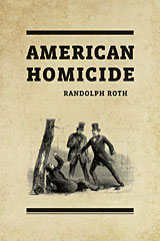Murder, He Wrote

Recently one of our esteemed senators (his name escapes me), in talking about our world-leading incarceration rate, offered that having so many people in jail might suggest that Americans are so terrible that we need to lock up so many. There are other explanations, of course, but they are more troublesome to the prison industrial complex.
It does seem, though, that this country loves its crime stories, and some of those more celebrated or infamous crimes are, of course, homicide.
Ohio State University historian Randolph Roth has compiled a substantial historical investigation, American Homicide (Harvard University Press), covering a period from the American colonial era to the present day, that concludes “the United States is distinctive in its level of violence among unrelated adults—friends, acquaintances, and strangers.” And if that’s not news, here’s what Roth identifies as factors in the fluctuation in those levels over the history of the USA and other Western nations: “political instability; a loss of government legitimacy; a loss of fellow-feeling among members of society caused by racial, religious, or political antagonism; and a loss of faith in the social hierarchy.” He points out these phenomena are why America leads the industrialized world in murder.
Harvard University historian and New Yorker writer Jill Lepore has a fascinating discussion of crime and punishment in a piece called “Rap Sheet,” which includes incisive commentary on Professor Roth’s tome and a citation of Cesare Beccaria’s treatise “On Crimes and Punishments,” published in 1764.
Long ago, Beccaria pointed out the meaningfulness of the correspondence, over time, between crime and punishment, between one kind of violence and another. If the history of murder contains a lesson, Beccaria believed, it was this: “The countries and times most notorious for severity of punishment have always been those in which the bloodiest and most inhumane of deeds were committed.”
